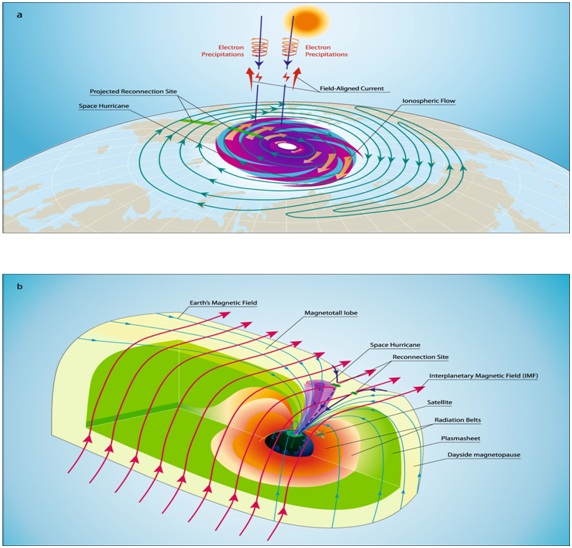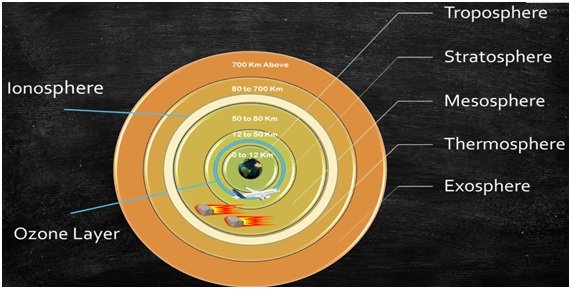The first known ‘space hurricane’ pours ‘electron rain’
- Posted By
10Pointer
- Categories
Geography
- Published
4th Mar, 2021
-
-
Context
|
GS-I: Geography
- Important Geophysical Phenomena
- Geographical features
|
Satellite observations have revealed an unprecedented ‘space hurricane’ in Earth’s upper atmosphere, for the first time.
-
Background
- Scientists have previously documented hurricanes in the lower atmospheres of Mars, Jupiter, and Saturn.
- Similar phenomena (enormous solar tornadoes) have even been spotted on the Sun.
- But the existence of space hurricanes, hurricane-like circulation patterns in planets’ upper atmospheres, was uncertain.
- The space hurricane was founded on August 20, 2014 and scientists discovered it retroactively.
- Researchers at Shandong University in China used satellite data to identify a space hurricane over Earth’s northern magnetic pole.
- With the new findings, scientists were able to create a 3-D image of the 1,000 km-wide swirling mass of plasma that rained electrons instead of water several hundred kilometers above the North Pole.
- The findings were published in the peer-reviewed British journal Nature Communications.
-
Analysis
The discovery
- A 'space hurricane' is a swirling mass of plasma. The space hurricane has been spotted in Earth’s ionosphere.
- The whole thing lasted nearly eight hours, depositing vast amounts of energy and momentum into the ionosphere.
- Features of space hurricane:
- The event was a whirling pattern not in the air, but in plasma, ionized gas that is found throughout the Solar System, including in Earth’s upper atmosphere.
- The hurricane was spinning in a counter-clockwise direction (like hurricanes do in the Northern Hemisphere), had multiple spiral arms.
- Like its more mundane counterparts, the space hurricane had a quiet center and widespread circulation.
- It also featured precipitation, but of energetic electrons rather than water droplets.

|
Hurricanes
- Tropical storms and hurricanes occur in Earth’s lower atmosphere over warm bodies of water such as oceans and gulfs.
- When warm, moist air rises, it creates an area of low pressure near the surface that sucks in the surrounding air, causing extremely strong winds and creating clouds that lead to heavy rain.
- A hurricane starts as a tropical disturbance. This is an area over warm ocean waters where rain clouds are building.
- A tropical disturbance sometimes grows into a tropical depression. This is an area of rotating thunderstorms with winds of 62 km/hr (38 mph) or less.
- A tropical depression becomes a tropical storm if its winds reach 63 km/hr (39 mph).
- A tropical storm becomes a hurricane if its winds reach 119 km/hr (74 mph).
- There are five types, or categories, of hurricanes. The scale of categories is called the Saffir-Simpson Hurricane Scale. The categories are based on wind speed.
- Category 1:Winds 119-153 km/hr (74-95 mph) - faster than a cheetah
- Category 2:Winds 154-177 km/hr (96-110 mph) - as fast or faster than a baseball pitcher's fastball
- Category 3:Winds 178-208 km/hr (111-129 mph) - similar, or close, to the serving speed of many professional tennis players
- Category 4:Winds 209-251 km/hr (130-156 mph) - faster than the world's fastest rollercoaster
- Category 5: Winds more than 252 km/hr (157 mph) - similar, or close, to the speed of some high-speed trains
|
-
How is it different and similar to earth hurricanes?
- Difference
- Electrons instead of water: Unlike other hurricanes, however, the space hurricane rained electrons into the ionosphere. This had a stunning effect: a huge, cyclone-shaped aurora below the hurricane.
- Similarity
- The space hurricane — which took place during a period of low geomagnetic activity — had many similar features with that of hurricanes of the Earth that form in Earth's lower atmosphere.
- However, in many ways, this space hurricane resembles the hurricanes that occur in the Earth’s lower atmosphere.
- Tropical storms are associated with huge amounts of energy, and these space hurricanes must be created by unusually large and rapid transfer of solar wind energy and charged particles into the Earth’s upper atmosphere.
|
Earth’s atmosphere
- Troposphere: The troposphere starts at the Earth's surface and extends 8 to 14.5 kilometers high (5 to 9 miles). This part of the atmosphere is the densest. Almost all weather is in this region.
- Stratosphere: The stratosphere starts just above the troposphere and extends to 50 kilometers (31 miles) high. The ozone layer, which absorbs and scatters the solar ultraviolet radiation, is in this layer.
- Mesosphere: The mesosphere starts just above the stratosphere and extends to 85 kilometers (53 miles) high. Meteors burn up in this layer
- Thermosphere: The thermosphere starts just above the mesosphere and extends to 600 kilometers (372 miles) high. Aurora and satellites occur in this layer.
- Ionosphere: The ionosphere is an abundant layer of electrons and ionized atoms and molecules that stretches from about 48 kilometers (30 miles) above the surface to the edge of space at about 965 km (600 miles), overlapping into the mesosphere and thermosphere.
- This dynamic region grows and shrinks based on solar conditions and divides further into the sub-regions: D, E, and F; based on what wavelength of solar radiation is absorbed.
- The ionosphere is a critical link in the chain of Sun-Earth interactions.
- This region is what makes radio communications possible.
- Exosphere: This is the upper limit of our atmosphere. It extends from the top of the thermosphere up to 10,000 km (6,200 mi).

|
-
Can they create problem?
- These space hurricanes can, probably, lead to:
- increased satellite problems
- disturbances in high-frequency radio communications, satellite navigation, communication systems
- increased errors in the over-the-horizon radar location
- grid failure
-
What hints do the findings give?
- Widespread phenomenon: Plasma and magnetic fields in the atmosphere of planets exist throughout the universe, so the findings suggest space hurricanes should be a widespread phenomenon.
- Relatively common: They could be more relatively common within our solar system and beyond.
-
Conclusion
The study of space hurricanes will help in understanding important space weather effects such as satellite drag, disturbances in high frequency (HF) radio communications, and errors in over-the-horizon radar location, satellite navigation, and communication systems better. However, further study is needed to know the complete picture of such an occurrence.
